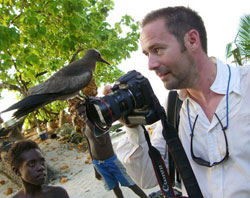 |
The Tide Is High
January 2007
|
 |
|||||||||
|
It all began in November 2005 when I read an article concerning rising sea levels and their effect on the low-level, one-meter-high coastline of the islands that make up the Carteret Atoll in the South Pacific. It sounded newsworthy, topical and tropical. Even though I knew little of how to get there, I was interested in going—I'd been to Kiribati Atoll on assignment a few months earlier and I wanted another Southern Pacific adventure.
I would be travelling with colleagues: a journalist, a videographer and a logistician for help and security. We all met up in Buka township in a half-star hotel with a five-star view of the Buka sea passage. We were on a fairly tight schedule and wished to visit the atoll as soon as possible. The usual vessels for making the four-hour crossing were 22-foot-long, open, single-engine, 40-hp "banana boats." But, the wind had been blowing for two weeks straight keeping those vessels in the sandy cove port. Even if the winds were to calm we were stuck--there was no fuel on the island. This was an outpost of Papua, New Guinea, and we were now on "island time."
Suddenly it all seemed too easy as we negotiated a quite expensive charter fee with our boat captain (but what price was too high for personal safety, air conditioning, a shower and electricity to recharge camera batteries?). We were trying to visit six islands where there is no electricity, no shops, no food to buy and no hotels. The people of the Carterets are suffering: their island coastlines are disappearing, their "gardens" regularly flooded with sea water, and their meager swamp taro and banana crops destroyed. Their only food source is now coconuts and fish; rumors floated of malnutrition and rampant malarial disease. On the morning of our departure we went shopping for our own provisions but also for supplies to give the islanders, to trade for fish and for possible shelter on the atoll.
For the next few days we anchored in the aqua-colored Tulun lagoon and explored the Carteret Islands first discovered by British navigator Philip Carteret in 1767. Covered in mosquito repellent and Factor80 sun block, I crisscrossed the lagoon, photographing on beaches eroded by the relentless sea, trying to figure out how to expose for the sun-blackened skin of the islanders against the sun-bleached sand.
I would shoot and listen as the islanders told me that "tides are changing and the weather is different," "the beach used to go out to there," and "the water came up to our waist." These islands all form one atoll but each had its own individual character and its own stories to tell. On Puil Island I was shown the crop gardens, now a barren wasteland after tidal waters had rampaged through. On Huene Island (population "about 20") I listened as Selina Netoi told me, "We live in fear. Maybe the next storm will take our little houses and our children and wash us all away." Selina has reason to be afraid, her island split in two in the 1970s, eroded through the middle by the sea. Now the beaches near her shack house are littered with the stumps of fallen coconut trees, their roots exposed by the waves. "We have little to eat and no one comes to buy our sea produce," she told me shrugging her shoulders, watched by the rest of her quiet and shy family, unaccustomed to white-skinned visitors, or to visitors in general.
Many islanders hope that a much talked about, but little acted upon, governmental plan to relocate them to the larger island of Bougainville will happen soon, but the future of the Carterets is uncertain. As I prepared to depart the island Bernard Tubin told me, "We live our life happily but because of this rushing of the sea, the current of the waves is so strong and we know people have been talking about this green-gas emission, we feel that our life is threatened and we don't know what is coming next."
The people of Carterets are by no means savage islanders living on a desert island; instead they are people with very few options trying to live the only life they know on a tiny remote atoll inhabited for previous centuries by their ancestors. They are Third-World islanders living with the actuality of rising sea levels, feeling the hotly debated effects of First-World consumption. Now they're in danger of becoming the world's first environmental refugees.
© Jeremy Sutton-Hibbert
Dispatches are brought to you by Canon. Send Canon a message of thanks. |
||||||||||
Back to January 2007 Contents
|
|


